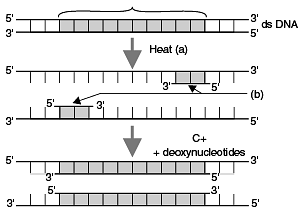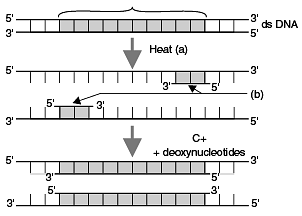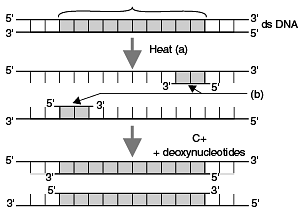Case Based Questions Test: Biotechnology: Principles & Processes - NEET MCQ
15 Questions MCQ Test Biology Class 12 - Case Based Questions Test: Biotechnology: Principles & Processes
A schematic representation of polymerase chain reaction (PCR) up to the extension stage is given below.

Q. Name the process ‘a’

A schematic representation of polymerase chain reaction (PCR) up to the extension stage is given below.

Q. PCR technique is best for :

| 1 Crore+ students have signed up on EduRev. Have you? Download the App |
A schematic representation of polymerase chain reaction (PCR) up to the extension stage is given below.

Q. Identify ‘b’

A schematic representation of polymerase chain reaction (PCR) upto extension stage is given below

Identify 'c'
A schematic representation of polymerase chain reaction (PCR) up to the extension stage is given below.

Q. Which of the following has popularized the PCR (Polymerase Chain Reaction) ?
Read the following text and answer the following question on the basis of the same:
The term biotechnology refers to the use of living organisms or their products to modify human health and their human environment. For example, ‘testtube’ programme, synthesis of a gene or correcting a defective gene are all part of biotechnology. The basis of modern biotechnology is genetic engineering and maintenance of sterile conditions. Genetic engineering is the technique that alter the chemistry of genetic material i.e. DNA and RNA, then this genetic material is introduced into host organisms, which alter the phenotype of the host organism.
Q. Discovery of _________ molecule made genetic engineering possible.
Read the following text and answer the following question on the basis of the same:
The term biotechnology refers to the use of living organisms or their products to modify human health and their human environment. For example, ‘testtube’ programme, synthesis of a gene or correcting a defective gene are all part of biotechnology. The basis of modern biotechnology is genetic engineering and maintenance of sterile conditions. Genetic engineering is the technique that alter the chemistry of genetic material i.e. DNA and RNA, then this genetic material is introduced into host organisms, which alter the phenotype of the host organism.
Q. The cutting of DNA at specific locations became possible with the discovery of :
Read the following text and answer the following question on the basis of the same:
The term biotechnology refers to the use of living organisms or their products to modify human health and their human environment. For example, ‘testtube’ programme, synthesis of a gene or correcting a defective gene are all part of biotechnology. The basis of modern biotechnology is genetic engineering and maintenance of sterile conditions. Genetic engineering is the technique that alter the chemistry of genetic material i.e. DNA and RNA, then this genetic material is introduced into host organisms, which alter the phenotype of the host organism.
Q. The recognition sequence of the first restriction enzyme isolated was ________ base pair long.
Read the following text and answer the following question on the basis of the same:
The term biotechnology refers to the use of living organisms or their products to modify human health and their human environment. For example, ‘testtube’ programme, synthesis of a gene or correcting a defective gene are all part of biotechnology. The basis of modern biotechnology is genetic engineering and maintenance of sterile conditions. Genetic engineering is the technique that alter the chemistry of genetic material i.e. DNA and RNA, then this genetic material is introduced into host organisms, which alter the phenotype of the host organism.
Q. DNA fragments are :
Read the following text and answer the following question on the basis of the same:
The term biotechnology refers to the use of living organisms or their products to modify human health and their human environment. For example, ‘testtube’ programme, synthesis of a gene or correcting a defective gene are all part of biotechnology. The basis of modern biotechnology is genetic engineering and maintenance of sterile conditions. Genetic engineering is the technique that alter the chemistry of genetic material i.e. DNA and RNA, then this genetic material is introduced into host organisms, which alter the phenotype of the host organism.
Q. The specific DNA sequence where EcoRI cuts is :
Read the following and answer the question given below :
Restriction endonuclease was isolated for the first time by W. Aber in 1962 in bacteria. Restriction endonucleases cut the DNA duplex at specific points therefore they are also called molecular scissors or biological scissors. Three types of restriction endonucleases are Type 1. Type ll and Type III but only Type II restriction endonucleases are used in recombinant DNA technology. Restriction endonuclease EcoR I recognises the base sequence GAATTC In DNA duplex and cut strands between G and A.
Q. Only type II restriction enzymes are used in gene manipulation because:
Read the following and answer the question given below :
Restriction endonuclease was isolated for the first time by W. Aber in 1962 in bacteria. Restriction endonucleases cut the DNA duplex at specific points therefore they are also called molecular scissors or biological scissors. Three types of restriction endonucleases are Type 1. Type ll and Type III but only Type II restriction endonucleases are used in recombinant DNA technology. Restriction endonuclease EcoR I recognises the base sequence GAATTC In DNA duplex and cut strands between G and A.
Q. Restriction endonucleases are also called as molecular or biological scissors because:
Read the following and answer the question given below :
Restriction endonuclease was isolated for the first time by W. Aber in 1962 in bacteria. Restriction endonucleases cut the DNA duplex at specific points therefore they are also called molecular scissors or biological scissors. Three types of restriction endonucleases are Type 1. Type ll and Type III but only Type II restriction endonucleases are used in recombinant DNA technology. Restriction endonuclease EcoR I recognises the base sequence GAATTC In DNA duplex and cut strands between G and A.
Q. Which of the following ions are used by restriction endonucleases for restriction?
Read the following and answer the question given below :
Restriction endonuclease was isolated for the first time by W. Aber in 1962 in bacteria. Restriction endonucleases cut the DNA duplex at specific points therefore they are also called molecular scissors or biological scissors. Three types of restriction endonucleases are Type 1. Type ll and Type III but only Type II restriction endonucleases are used in recombinant DNA technology. Restriction endonuclease EcoR I recognises the base sequence GAATTC In DNA duplex and cut strands between G and A.
Q. Which type of restriction endonucleases is used most in genetic engineering?
Read the following and answer the question given below :
Restriction endonuclease was isolated for the first time by W. Aber in 1962 in bacteria. Restriction endonucleases cut the DNA duplex at specific points therefore they are also called molecular scissors or biological scissors. Three types of restriction endonucleases are Type 1. Type ll and Type III but only Type II restriction endonucleases are used in recombinant DNA technology. Restriction endonuclease EcoR I recognises the base sequence GAATTC In DNA duplex and cut strands between G and A.
Q. Restriction endonuclease was isolated for the first time from a:
|
87 videos|294 docs|185 tests
|

















